[English] 日本語
 Yorodumi
Yorodumi- PDB-2rse: NMR structure of FKBP12-mTOR FRB domain-rapamycin complex structu... -
+ Open data
Open data
- Basic information
Basic information
| Entry | Database: PDB / ID: 2rse | ||||||
|---|---|---|---|---|---|---|---|
| Title | NMR structure of FKBP12-mTOR FRB domain-rapamycin complex structure determined based on PCS | ||||||
 Components Components |
| ||||||
 Keywords Keywords | ISOMERASE/TRANSFERASE / FKBP12 / rapamycin / FK506 / lanthanide / PCS / ISOMERASE-TRANSFERASE complex | ||||||
| Function / homology |  Function and homology information Function and homology informationRNA polymerase III type 2 promoter sequence-specific DNA binding / RNA polymerase III type 1 promoter sequence-specific DNA binding / positive regulation of cytoplasmic translational initiation / regulation of locomotor rhythm / T-helper 1 cell lineage commitment / positive regulation of pentose-phosphate shunt / positive regulation of wound healing, spreading of epidermal cells / TORC2 signaling / TORC2 complex / regulation of membrane permeability ...RNA polymerase III type 2 promoter sequence-specific DNA binding / RNA polymerase III type 1 promoter sequence-specific DNA binding / positive regulation of cytoplasmic translational initiation / regulation of locomotor rhythm / T-helper 1 cell lineage commitment / positive regulation of pentose-phosphate shunt / positive regulation of wound healing, spreading of epidermal cells / TORC2 signaling / TORC2 complex / regulation of membrane permeability / cellular response to leucine starvation / macrolide binding / negative regulation of lysosome organization / heart valve morphogenesis / TFIIIC-class transcription factor complex binding / activin receptor binding / TORC1 complex / voluntary musculoskeletal movement / positive regulation of transcription of nucleolar large rRNA by RNA polymerase I / calcineurin-NFAT signaling cascade / RNA polymerase III type 3 promoter sequence-specific DNA binding / positive regulation of keratinocyte migration / regulation of skeletal muscle contraction by regulation of release of sequestered calcium ion / regulation of osteoclast differentiation / transforming growth factor beta receptor binding / cytoplasmic side of membrane / regulation of lysosome organization / MTOR signalling / TGFBR1 LBD Mutants in Cancer / cellular response to nutrient / cellular response to L-leucine / energy reserve metabolic process / Amino acids regulate mTORC1 / regulation of autophagosome assembly / type I transforming growth factor beta receptor binding / Energy dependent regulation of mTOR by LKB1-AMPK / TORC1 signaling / negative regulation of activin receptor signaling pathway / ruffle organization / serine/threonine protein kinase complex / cellular response to methionine / heart trabecula formation / I-SMAD binding / negative regulation of cell size / positive regulation of ubiquitin-dependent protein catabolic process / cellular response to osmotic stress / negative regulation of protein localization to nucleus / anoikis / inositol hexakisphosphate binding / regulation of amyloid precursor protein catabolic process / signaling receptor inhibitor activity / terminal cisterna / ryanodine receptor complex / cardiac muscle cell development / negative regulation of calcineurin-NFAT signaling cascade / regulation of myelination / 'de novo' protein folding / positive regulation of transcription by RNA polymerase III / negative regulation of macroautophagy / ventricular cardiac muscle tissue morphogenesis / Macroautophagy / positive regulation of myotube differentiation / FK506 binding / regulation of cell size / Constitutive Signaling by AKT1 E17K in Cancer / positive regulation of actin filament polymerization / germ cell development / TOR signaling / behavioral response to pain / TGF-beta receptor signaling activates SMADs / mTORC1-mediated signalling / oligodendrocyte differentiation / positive regulation of oligodendrocyte differentiation / positive regulation of translational initiation / regulation of ryanodine-sensitive calcium-release channel activity / Calcineurin activates NFAT / CD28 dependent PI3K/Akt signaling / HSF1-dependent transactivation / regulation of macroautophagy / regulation of immune response / response to amino acid / 'de novo' pyrimidine nucleobase biosynthetic process / positive regulation of epithelial to mesenchymal transition / vascular endothelial cell response to laminar fluid shear stress / positive regulation of lipid biosynthetic process / heart morphogenesis / cellular response to nutrient levels / neuronal action potential / regulation of cellular response to heat / positive regulation of lamellipodium assembly / cardiac muscle contraction / phagocytic vesicle / T cell costimulation / positive regulation of stress fiber assembly / supramolecular fiber organization / cytoskeleton organization / endomembrane system / sarcoplasmic reticulum membrane / negative regulation of insulin receptor signaling pathway / negative regulation of autophagy Similarity search - Function | ||||||
| Biological species |  Homo sapiens (human) Homo sapiens (human) | ||||||
| Method | SOLUTION NMR / simulated annealing | ||||||
| Model details | lowest energy, model 1 | ||||||
 Authors Authors | Kobashigawa, Y. / Ushio, M. / Saio, T. / Inagaki, F. | ||||||
 Citation Citation |  Journal: J.Biomol.Nmr / Year: 2012 Journal: J.Biomol.Nmr / Year: 2012Title: Convenient method for resolving degeneracies due to symmetry of the magnetic susceptibility tensor and its application to pseudo contact shift-based protein-protein complex structure determination. Authors: Kobashigawa, Y. / Saio, T. / Ushio, M. / Sekiguchi, M. / Yokochi, M. / Ogura, K. / Inagaki, F. | ||||||
| History |
|
- Structure visualization
Structure visualization
| Structure viewer | Molecule:  Molmil Molmil Jmol/JSmol Jmol/JSmol |
|---|
- Downloads & links
Downloads & links
- Download
Download
| PDBx/mmCIF format |  2rse.cif.gz 2rse.cif.gz | 1.3 MB | Display |  PDBx/mmCIF format PDBx/mmCIF format |
|---|---|---|---|---|
| PDB format |  pdb2rse.ent.gz pdb2rse.ent.gz | 1.1 MB | Display |  PDB format PDB format |
| PDBx/mmJSON format |  2rse.json.gz 2rse.json.gz | Tree view |  PDBx/mmJSON format PDBx/mmJSON format | |
| Others |  Other downloads Other downloads |
-Validation report
| Summary document |  2rse_validation.pdf.gz 2rse_validation.pdf.gz | 427.6 KB | Display |  wwPDB validaton report wwPDB validaton report |
|---|---|---|---|---|
| Full document |  2rse_full_validation.pdf.gz 2rse_full_validation.pdf.gz | 632.4 KB | Display | |
| Data in XML |  2rse_validation.xml.gz 2rse_validation.xml.gz | 93.4 KB | Display | |
| Data in CIF |  2rse_validation.cif.gz 2rse_validation.cif.gz | 97.5 KB | Display | |
| Arichive directory |  https://data.pdbj.org/pub/pdb/validation_reports/rs/2rse https://data.pdbj.org/pub/pdb/validation_reports/rs/2rse ftp://data.pdbj.org/pub/pdb/validation_reports/rs/2rse ftp://data.pdbj.org/pub/pdb/validation_reports/rs/2rse | HTTPS FTP |
-Related structure data
| Similar structure data | |
|---|---|
| Other databases |
- Links
Links
- Assembly
Assembly
| Deposited unit | 
| |||||||||
|---|---|---|---|---|---|---|---|---|---|---|
| 1 |
| |||||||||
| NMR ensembles |
|
- Components
Components
| #1: Protein | Mass: 11836.508 Da / Num. of mol.: 1 Source method: isolated from a genetically manipulated source Source: (gene. exp.)  Homo sapiens (human) / Gene: FKBP1A, FKBP1, FKBP12 / Production host: Homo sapiens (human) / Gene: FKBP1A, FKBP1, FKBP12 / Production host:  |
|---|---|
| #2: Protein | Mass: 11331.937 Da / Num. of mol.: 1 / Fragment: UNP RESIDUES 2019-2112 Source method: isolated from a genetically manipulated source Source: (gene. exp.)  Homo sapiens (human) / Gene: MTOR, FRAP, FRAP1, FRAP2, RAFT1, RAPT1 / Production host: Homo sapiens (human) / Gene: MTOR, FRAP, FRAP1, FRAP2, RAFT1, RAPT1 / Production host:  References: UniProt: P42345, non-specific serine/threonine protein kinase |
| #3: Chemical |
-Experimental details
-Experiment
| Experiment | Method: SOLUTION NMR / Details: PCS-based rigid body docking structure |
|---|---|
| NMR experiment | Type: 2D 1H-15N  HSQC HSQC |
- Sample preparation
Sample preparation
| Details | Contents: 0.3 mM FKBP12-1, 0.3 mM [U-98% 15N] FRB-2, 90% H2O/10% D2O Solvent system: 90% H2O/10% D2O | ||||||||||||
|---|---|---|---|---|---|---|---|---|---|---|---|---|---|
| Sample |
| ||||||||||||
| Sample conditions | Ionic strength: 0.15 / pH: 7 / Pressure: ambient / Temperature: 298 K |
-NMR measurement
| NMR spectrometer | Type: Varian INOVA / Manufacturer: Varian / Model: INOVA / Field strength: 600 MHz |
|---|
- Processing
Processing
| NMR software | Name:  X-PLOR NIH / Developer: Schwieters, Kuszewski, Tjandra and Clore / Classification: refinement X-PLOR NIH / Developer: Schwieters, Kuszewski, Tjandra and Clore / Classification: refinement |
|---|---|
| Refinement | Method: simulated annealing / Software ordinal: 1 |
| NMR representative | Selection criteria: lowest energy |
| NMR ensemble | Conformer selection criteria: structures with the lowest energy Conformers calculated total number: 100 / Conformers submitted total number: 20 / Representative conformer: 1 |
 Movie
Movie Controller
Controller


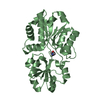
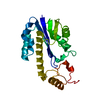

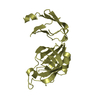
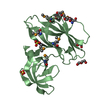

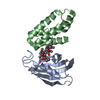
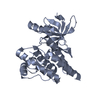
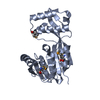

 PDBj
PDBj














